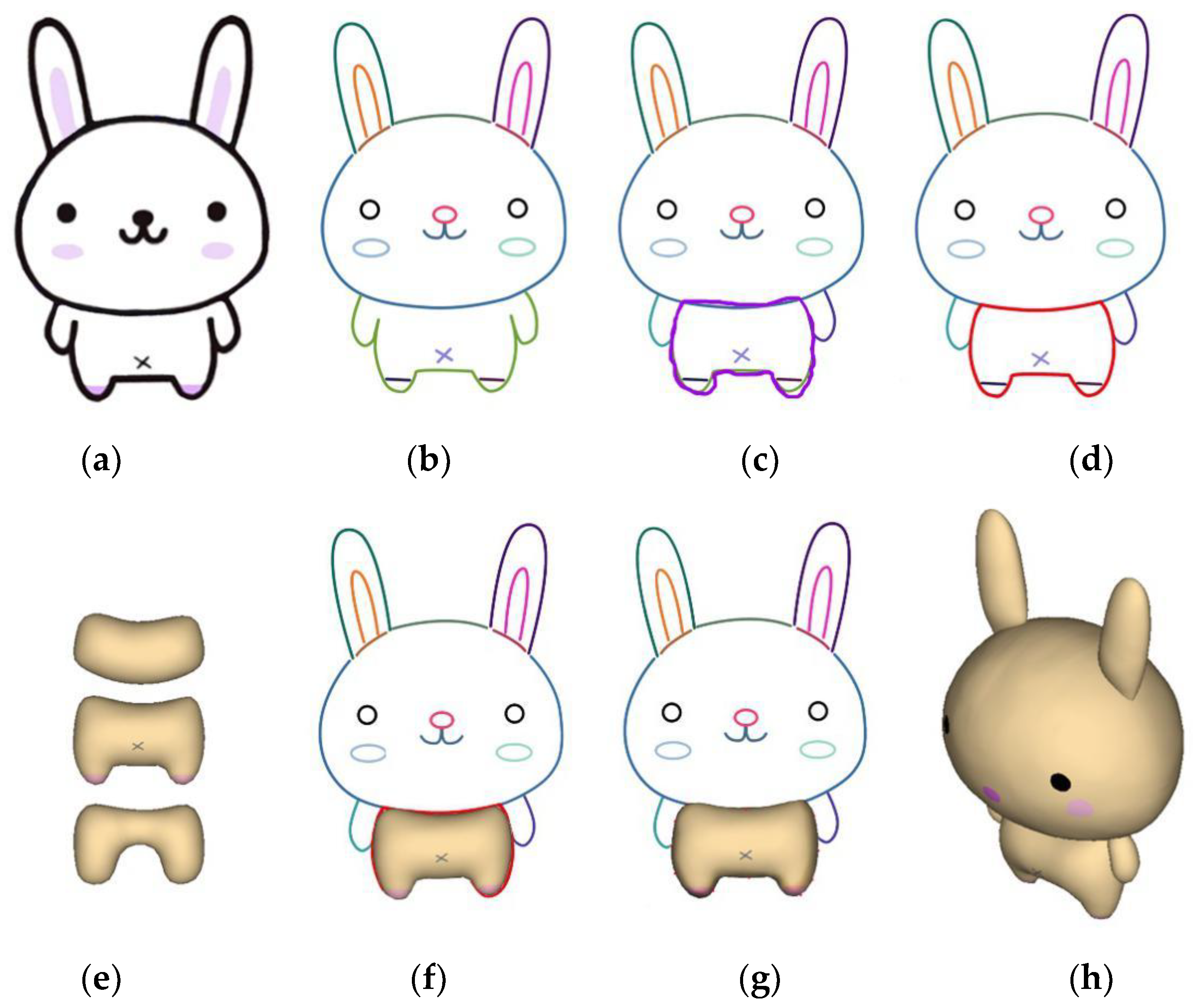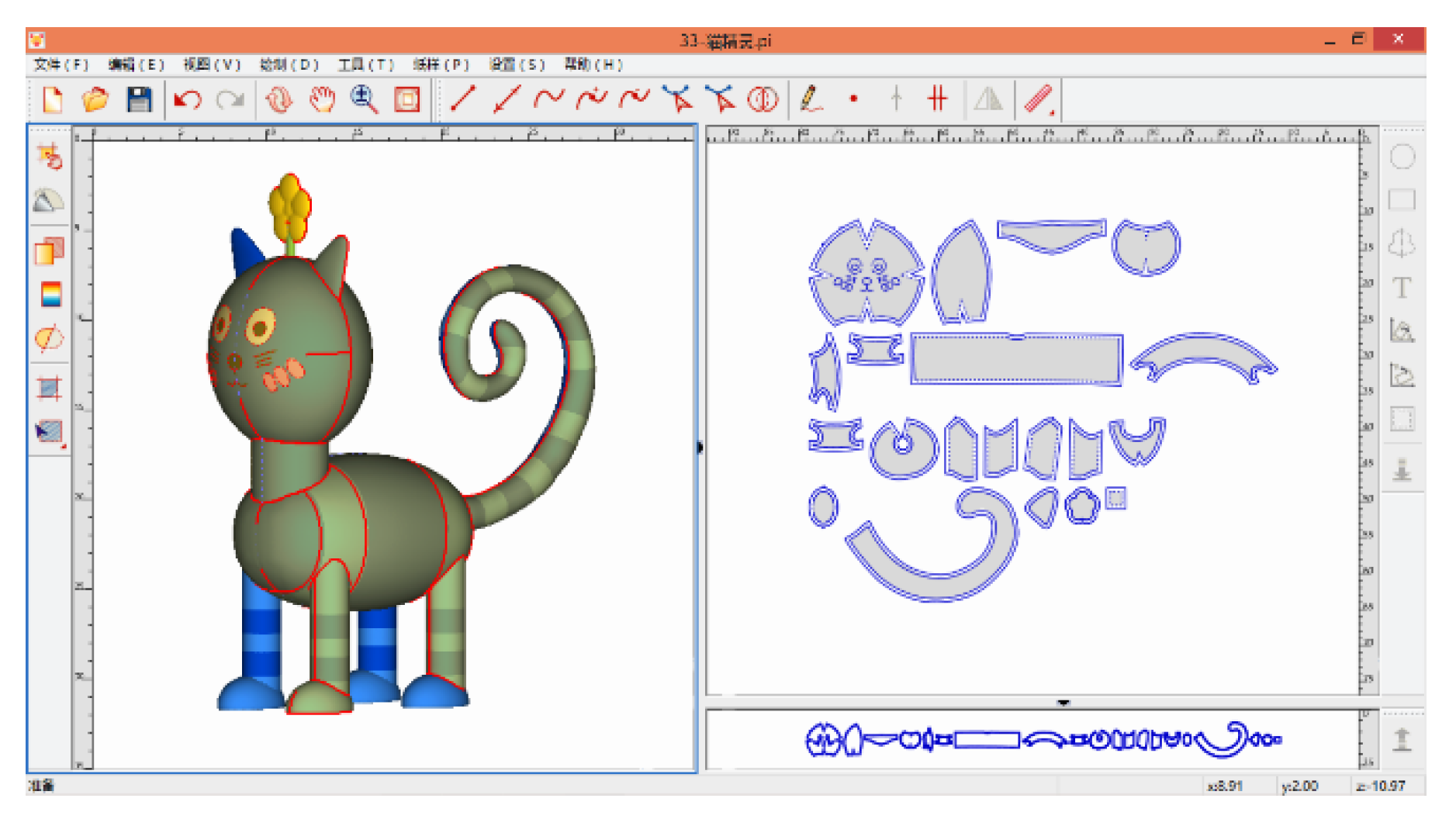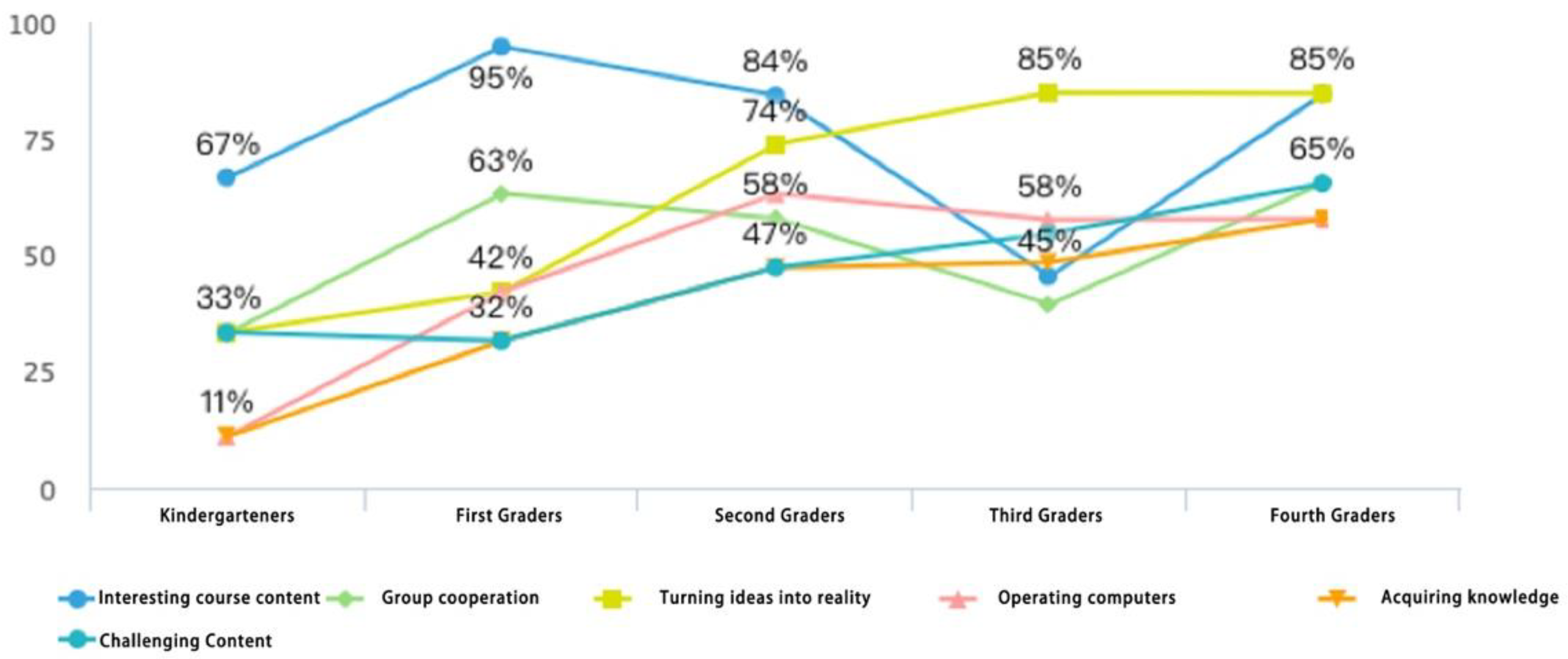Students’ Attitudes and Competences in Modeling Using 3D Cartoon Toy Design Maker
Abstract
:1. Introduction and Objectives
- (1)
- What are the initial attitudes of students of different ages towards learning 3D design?
- (2)
- What modeling concepts do students master after the 3D cartoon toy design course?
- (3)
- How involved are students in different aspects of Bers’ PTD evaluation framework in the 3D cartoon toy design course?
- (4)
- What experience do teachers gain?
2. Related Work
2.1. Maker Education for Students
2.2. Sketch-Based Modeling
3. Methods
3.1. Participants
3.2. Instruments
3.2.1. Students’ Attitude Survey
3.2.2. 3D Modeling Knowledge Task
3.2.3. Comprehensive Competency Assessments
3.2.4. Teacher Interviews and Daily Records
3.3. Procedure
3.4. Date Analysis
4. Results
4.1. Students’ Attitude
4.2. 3D Modeling Knowledge
4.3. Comprehensive Competency Assessments
4.4. Teachers’ Experience
5. Discussion and Conclusions
- (1)
- The attitude scores demonstrated that the participation of junior students in the course was mainly influenced by the fun nature of the course, whereas the participation of senior students in the course was more because of their demand for technology.
- (2)
- The students’ 3D modeling knowledge scores demonstrated that all students were highly successful at mastering foundational modeling concepts. At the same time, the study provided preliminary evidence that 3D modeling software could be a useful and educational tool in the classroom.
- (3)
- The PTD scores indicated that students in this study showed high engagement across PTD behaviors. Students not only had fun working during the course, but also showed positive learning outcomes.
- (4)
- Results from the teachers’ interviews and daily records indicate that the course was not only a positive experience for students, but also for them. Teachers were able to promote a collaborative, communicative, and creative environment in the course, and were able to make flexible adjustments to the course according to the actual classroom environment.
6. Limitations and Foresight
- It takes too little time to complete the 3D cartoon toy design course in eight weeks, especially for kindergarten students, who cannot fully understand and practice the learning concept. Lower-grade students with slower behavior need more time to learn and practice than upper-grade students. Although they could complete the course content and tasks and produced their own cartoon toys, students in lower grades rarely made complex ones.
- As an exploratory study, this paper applies only to a small sample population. Future research can expand the sample size to produce broader results.
- The tools and courses can be adjusted and redesigned accordingly.
- The deformation function modules of the tool can be simplified to give students more convenience.
- The demonstration of abstract modeling concepts can be strengthened to further educate students.
Author Contributions
Funding
Institutional Review Board Statement
Informed Consent Statement
Data Availability Statement
Acknowledgments
Conflicts of Interest
Appendix A. Developing a 3D Cartoon Toy Design Curriculum System
Appendix A.1. 3D Cartoon Design Software



Appendix A.2. 3D Cartoon Toy Design Course

- Unit 1: Inspire Creative Thinking: What Is the Cartoon Image Design?
- Unit 2: From 2D Drawing to 3D Modeling
- Unit 3: Pattern Design: Exploring the Relationship Between Body and Surface
- Unit 4: Handcraft
- Unit 5: Interactive and Creative Display
Appendix B
| Six C’s | Definition |
|---|---|
| Communication | Students exchange ideas with each other. Students seek help and ask questions. |
| Collaboration | Students work with others and willingly cooperate on a shared task. Students borrow materials from or provide them to each other. |
| Community building | Students volunteer to share their work with others. Students enhance the quality of their relationship with others. |
| Content creation | Students use a computer application to create content. Students debug problems in their work. |
| Creativity | Students use a variety of materials for their work. Students use technology in creative ways. |
| Choices of conduct | Students follow classroom rules. Students respect other students and teachers. |
Appendix C
| Types of Changes | Examples/Quotes |
|---|---|
| Adding activities | Before the cartoon image design, students are asked to show what kind of toy image they want to design, and why they want to make such a toy. |
| Skipping activities | Some teachers’ introductions and demonstrations of software functions and material applications are deleted, enabling students to explore the functions of software and the features of materials in hands-on operation. |
| Adjusting activities | The mutual evaluation among students is adjusted to mutual evaluation between groups so that students can be more team-oriented in competition. |
| Adjusting time | The time of the paper pattern design is shortened and the time of handcraft course is increased. Students usually cannot complete the sewing of the toy in two lessons. |
Appendix D
| Themes | Explanations |
|---|---|
| Learning interest | Students were very curious about the course content, and eager to participate. They wanted to design and produce their own toys. |
| Autonomic learning | Students actively explored how to use the software. Students tried to make toy models with different materials. |
| Hands-on ability | Students carefully sewed their toys and filled them. |
| Collaboration and communication | Students cooperated with each other. Students actively participated in group discussions. |
References
- Danniels, E.; Pyle, A.; DeLuca, C. The role of technology in supporting classroom assessment in play-based kindergarten. Teach. Teach. Educ. 2020, 88, 102966. [Google Scholar] [CrossRef]
- Bers, M.U. Coding as a Playground: Programming and Computational Thinking in the Early Childhood Classroom; Routledge: New York, NY, USA, 2020. [Google Scholar]
- Stéphan, V.-L.; Joaquin, U.; Soumyajit, K.; Gwénaël, J. Measuring Innovation in Education 2019: What Has Changed in the Classroom? Educational Research and Innovation; OECD Publishing: Paris, France, 2019. [Google Scholar]
- Hsu, Y.-C.; Baldwin, S.; Ching, Y.-H. Learning through making and maker education. TechTrends 2017, 61, 589–594. [Google Scholar] [CrossRef]
- Tian, Y. Maker education: Origin, connotation and possible path. Comp. Educ. Study 2016, 38, 22–28. [Google Scholar]
- Richards, J.C. Teaching Listening and Speaking; Cambridge University Press: Cambridge, UK, 2008. [Google Scholar]
- Taylor, B. Evaluating the benefit of the maker movement in K-12 STEM education. Electron. Int. J. Educ. Arts Sci. 2016, 2, 1–22. [Google Scholar]
- Serholt, S. Breakdowns in children’s interactions with a robotic tutor: A longitudinal study. Comput. Hum. Behav. 2018, 81, 250–264. [Google Scholar] [CrossRef]
- Pierce, P.L. Technology Integration Intoearly Childhood Curricula: Where We’ve Been, Where We Are, Where We Should Go; University of North Carolina: Chapel Hill, NC, USA, 1994; p. 65. [Google Scholar]
- Millard, J.; Sorivelle, M.N.; Deljanin, S.; Unterfrauner, E.; Voigt, C. Is the maker movement contributing to sustainability? Sustainability 2018, 10, 2212. [Google Scholar] [CrossRef]
- Bers, M.U. Designing Digital Experiences for Positive Youth Development: From Playpen to Playground; Oxford University Press: New York, NY, USA, 2012. [Google Scholar]
- Weng, J.; Li, H. Early technology education in China: A case study of Shanghai. Early Child Dev. Care 2020, 190, 1574–1585. [Google Scholar] [CrossRef]
- Sullivan, A.; Bers, M.U. Robotics in the early childhood classroom: Learning outcomes from an 8-week robotics curriculum in pre-kindergarten through second grade. Int. J. Technol. Des. Educ. 2016, 26, 3–20. [Google Scholar] [CrossRef]
- Otterborn, A.; Schönborn, K.; Hultén, M. Surveying preschool teachers’ use of digital tablets: General and technology education related findings. Int. J. Technol. Des. Educ. 2018, 29, 717–737. [Google Scholar] [CrossRef]
- Johansson, A.-M. Examining how technology is presented and understood in technology education: A pilot study in a preschool class. Int. J. Technol. Des. Educ. 2021, 31, 885–900. [Google Scholar] [CrossRef]
- Davis, J. Revealing the research ‘hole’of early childhood education for sustainability: A preliminary survey of the literature. Environ. Educ. Res. 2009, 15, 227–241. [Google Scholar] [CrossRef]
- Zheng, Y.; Luyi, L.I. Connotation, characteristics and implementation path of K- 12 learning by making in the USA. Open Educ. Res. 2014, 20, 42–49. [Google Scholar]
- Maosheng, Q. The Application of Maker Education in Primary School Mathematics. China J. Multimed. Netw. Teach. 2020, 4, 30–40. [Google Scholar]
- Hatisaru, V. Draw a mathematics classroom: Teaching and learning practices through the eyes of students. Math. Sch. 2021, 50, 4–8. [Google Scholar]
- Hu, Z. Middle school maker education curriculum development—Take the App Inventor as an example. Prim. Middle Sch. Inf. Technol. Educ. 2016, 2, 59–62. [Google Scholar]
- Srinivasan, A.; Lee, B.; Henry Riche, N.; Drucker, S.M.; Hinckley, K. InChorus: Designing consistent multimodal interactions for data visualization on tablet devices. In Proceedings of the 2020 CHI Conference on Human Factors in Computing Systems, Honolulu, HI, USA, 25–30 April 2020; pp. 1–13. [Google Scholar]
- Bers, M.U.; Ponte, I.; Juelich, C.; Viera, A.; Schenker, J. Teachers as Designers: Integrating Robotics in Early Childhood Education. Inf. Technol. Child. Educ. Annu. 2002, 2002, 123–145. [Google Scholar]
- Abrar, M.; Sidik, E.J. Analyzing ethical considerations and research methods in children research. J. Educ. Learn. (EduLearn) 2019, 13, 184–193. [Google Scholar] [CrossRef]
- Ankiewicz, P. Perceptions and attitudes of pupils towards technology: In search of a rigorous theoretical framework. Int. J. Technol. Des. Educ. 2019, 29, 37–56. [Google Scholar] [CrossRef]
- Svenningsson, J.; Hultén, M.; Hallstrm, J. Understanding attitude measurement: Exploring meaning and use of the PATT short questionnaire. Int. J. Technol. Des. Educ. 2018, 28, 67–83. [Google Scholar] [CrossRef]
- Ardies, J.; De Maeyer, S.; Gijbels, D. Reconstructing the Pupils Attitude towards Technology-survey. Des. Technol. Educ. 2013, 18, 8–19. [Google Scholar]
- Chau, C.L. Positive technological development for young children in the context of children’s mobile apps. J. Chem. Inf. Modeling 2014, 140, 3624692. [Google Scholar] [CrossRef]
- Sullivan, A.; Bers, M.U. Dancing robots: Integrating art, music, and robotics in Singapore’s early childhood centers. Int. J. Technol. Des. Educ. 2017, 28, 325–346. [Google Scholar] [CrossRef]
- Hsieh, H.-F. Three Approaches to Qualitative Content Analysis. Qual. Health Res. 2005, 15, 1277–1288. [Google Scholar] [CrossRef] [PubMed]
- McCarthy, M. Experiential learning theory: From theory to practice. J. Bus. Econ. Res. 2010, 8, 131–140. [Google Scholar] [CrossRef]
- Easton, P. Adult Education and Social Sustainability: Harnessing the “Red Queen Effect”. Convergence 2007, 40, 171–185. [Google Scholar]
- Bakker, M.; van den Heuvel-Panhuizen, M.; Robitzsch, A. Effects of playing mathematics computer games on primary school students’ multiplicative reasoning ability. Contemp. Educ. Psychol. 2015, 40, 55–71. [Google Scholar] [CrossRef]
- Hsiao, H.S.; Chang, C.S.; Lin, C.Y.; Hu, P.M. Development of children’s creativity and manual skills within digital game-based learning environment. J. Comput. Assist. Learn. 2014, 30, 377–395. [Google Scholar] [CrossRef]
- Hwang, G.-J.; Wu, P.-H.; Chen, C.-C. An online game approach for improving students’ learning performance in web-based problem-solving activities. Comput. Educ. 2012, 59, 1246–1256. [Google Scholar] [CrossRef]
- Prensky, M. Digital game-based learning. Comput. Entertain. (CIE) 2003, 01, 21. [Google Scholar] [CrossRef]
- Dochshanov, A.; Tramonti, M. Re-making Classroom Borders with TINKERING Approach. In Proceedings of the International Pixel Conference—New Perspectives in Science Education, Florence, Italy, 22–23 March 2018. [Google Scholar]
- Kiili, K.; Freitas, S.D.; Arnab, S.; Lainema, T. The design principles for flow experience in educational games. Procedia Comput. Sci. 2012, 15, 78–91. [Google Scholar] [CrossRef]
- Anzai, Y.; Simon, H.A. The theory of learning by doing. Psychol. Rev. 1979, 86, 124–140. [Google Scholar] [CrossRef] [PubMed]
- Silby, A.; Watts, M. Making the tacit explicit: Children’s strategies for classroom writing. Br. Educ. Res. J. 2015, 41, 801–819. [Google Scholar] [CrossRef]
- Carrico, M.; Kim, V. Expanding zero-waste design practices: A discussion paper. Int. J. Fash. Des. Technol. Educ. 2014, 7, 58–64. [Google Scholar] [CrossRef]







| School | Grade | Sample Size | Age | |
|---|---|---|---|---|
| 1 | Kindergarten X | K-3 | 19 | 6–7 |
| 2 | Primary school Y | First grade | 18 | 7–8 |
| 3 | Primary school Y | Second grade | 20 | 8–9 |
| 4 | Primary school Z | Third grade | 19 | 9–10 |
| 5 | Primary school Z | Fourth grade | 17 | 11–12 |
Publisher’s Note: MDPI stays neutral with regard to jurisdictional claims in published maps and institutional affiliations. |
© 2022 by the authors. Licensee MDPI, Basel, Switzerland. This article is an open access article distributed under the terms and conditions of the Creative Commons Attribution (CC BY) license (https://creativecommons.org/licenses/by/4.0/).
Share and Cite
Fu, Y.; Zhang, D.; Jiang, H. Students’ Attitudes and Competences in Modeling Using 3D Cartoon Toy Design Maker. Sustainability 2022, 14, 2176. https://doi.org/10.3390/su14042176
Fu Y, Zhang D, Jiang H. Students’ Attitudes and Competences in Modeling Using 3D Cartoon Toy Design Maker. Sustainability. 2022; 14(4):2176. https://doi.org/10.3390/su14042176
Chicago/Turabian StyleFu, Yu, Dongliang Zhang, and Hao Jiang. 2022. "Students’ Attitudes and Competences in Modeling Using 3D Cartoon Toy Design Maker" Sustainability 14, no. 4: 2176. https://doi.org/10.3390/su14042176





